CALLIBAETIS
According to Mayflies of the World, A catalog of the Family and Genus Group Taxa, (Insecta: Ephemeroptera) By Michael D. Hubbard, published in 1990, Callibaetis are found in both North & South America.
Order: Ephemeroptera
Family: Baetidae
Genus: Callibaetis
Species: nigrius
coloradensis
fluctuans
pretiosus
Mayflies, published in 1997 by Malcolm Knopp and Robert Cormier, tell us that the Callibaetis genus remains but the species have been renamed. But for the purposes of the paper the old name will better serve. My first involvement with Callibaetis came early in my fishing career in Colorado. At the time my library was much more limited than it is today. However, one book that I did have was Matching the Hatch, by Ernest G. Schwiebert which was published in 1955. Later I referred to Nymphs, published in 1973 by the same author. As my fishing career continued I found out just how important the Callibaetis species can be and I found out that if you don’t have the proper patterns and if you don’t know how to properly present them, you can be in big trouble.
Callibaetis species are multi-brood insects, meaning that they produce many broods per year.
They have slender, tapered, streamlined bodies, with three tails and a pronounced hump in the thorax. Callibaetis are classed as active swimming nymphs and are often described as a clambering nymph. Both the nymphs and the duns tend to take on the colors of the environment that they inhabit and may vary from area to area. The common name for these mayflies is Speckled Dun!
Callibaetis species inhabit lakes, ponds and slow moving streams which contain weedbeds. Two to three hours prior to emergence nymphs should be fished along rocks, bottoms, ledges and weedbeds. At this point the nymphs should be fished deep. Retrieves should be 6 to 10 inch darts with a quick hand twist retrieve. Approximately one hour prior to the actual emergence the nymphs will start swimming back & forth from the weedbeds and the surface. This action should be noted as it is very unusual. The other reason that it should be noted is that the angler can take advantage of this action. Fish a weighted nymph with a hand twist figure eight while raising the rod tip and then dropping it.
During the actual emergence the imitations are just under or awash and floating in the film. Not all of the nymphs make it all the way to the surface before hatching. Many of the insects will hatch out three to six inches under the surface. Callibaetis hatches always have a large number of cripples and stillborns. The hatching off the water will depend on the temperature and humidity. Early season Callibaetis tend to be larger size 13’s to 14’s.
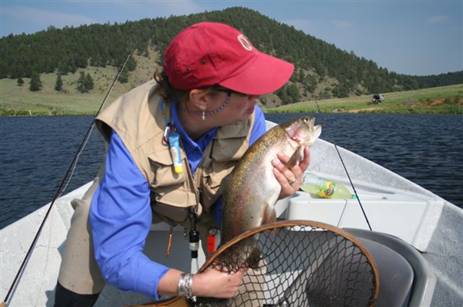
Taken on a Callibaetis Spider fished behind a Callibaetis Paradun
Later in the season they are smaller being size 16 and 18. In North America, the Callibaetis Spinners fall in late morning to mid-day, with the actual emergence taking place during the mid-morning. However, it should be noted that I have recorded many Callibaetis spinner falls that have taken place in the late evenings.
As with other mayfly hatches, the best and heaviest hatches will occur on cooler damp days where the duns stay on the water for long periods. The angler needs knowledge of both the hatch and the trout that feed on them. This information can be obtained through observation, sampling the water to be fished for insects and by using a stomach pump on the trout you catch. The stomach pump can help the angler solve a lot of problems, because the information you obtain from a trout and a stomach pump is information that comes straight from the trout’s month, so to speak!!
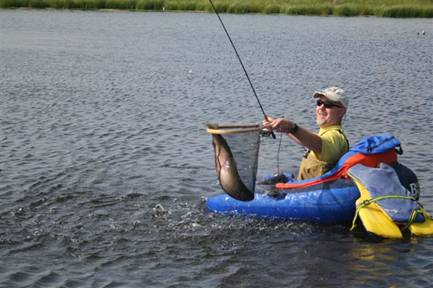
A nice trout taken on a Callibaetis Flymph
Hatches can also occur on inflow and outflow of lakes. Therefore you can find hatches on water that doesn’t typically have Callibaetis hatches. In calm water the nymphs will often perch on the stalks of vegetation. Often trout can be seen cruising the edges of the weedbeds picking off the nymphs. Remember the Callibaetis are known for getting stuck in the shuck during the emergence. Another interesting point is that the male spinners have clear wings and the female have mottled wings. The nymphs have three tails but the duns and spinners only have two. Prior to the actual hatch the trout will key on the active swimming nymph. Use a dun or emerger with a nymph 12 to 18 inches dropped behind the floating fly. This tandem can be deadly! If the hatch is scattered then nymphs and emergers throughout the hatch is the way to go.
Tips on Still-waters: In wind stirred opaque lakes, light will reach about 15 feet. In clear lakes the light can reach up to 25 feet. This information will tell you the deepest you will have to present the imitations.
During spinner falls a spent pattern with a soft hackle 12 to 18 inches behind is a deadly combination.
The patterns that I have listed are the ones that I have developed for fishing in North America. My Callibaetis pattern book has 29 patterns listed. In part one of this selection I will be sharing my favorite six wet imitations along with recipes and photo’s of the flies I will also include a few observations on when and how to fish them. In part two I will be covering the emergers and adult dry flies.
1. Callibaetis Soft Hackle—Style #1
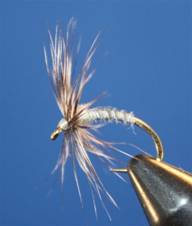
- Hook: TMC 2487
- Sizes: 14-18
- Thread: 12/0 Lite Dun
- Abdomen: Muskrat Gray, Turkey Wing Quill Fibers
- Thorax: Scintilla #10 Transparent Gray
- Hackle: Grizzly, Hen, wet, two wraps
Fishing Notes: The Callibaetis Soft Hackle can be used with many different fly lines and lends itself to hand-twist retrieve method. Oftentimes, I will use the soft hackle a trailer off of both nymphs and dry flies.
2. Callibaetis Flymph-------Style #2
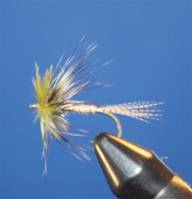
- Hook: TMC 101
- Sizes: 14-18
- Thread: 12/0 Sandy Dun
- Tails: Wood duck Flank Feather Fibers
- Abdomen: Callibaetis Turkey Biots
- Thorax: Dubbed, Squirrel Brite, Dark Gray
- 1st Hackle: Wet Hen Grizzly Hackle, two wraps
- 2nd Hackle: Olive After-Shaft (Philo Plume), two wraps
Fishing Notes: This is one of my favorite imitations to use during the emergence, at tiny micro shot will allow to place the imitation eight to ten inches beneath the surface and then retrieve and raise and drop the rod tip. When left unweighted, it will swim awash in or just under the surface film. In both cases it can be very effective.
3. Callibaetis Nymph----Weighted
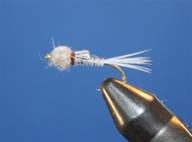
- Hook: TMC 101
- Sizes: 14-18
- Thread: Lite Dun 12/0
- Weight: Four wraps of .011 Lead Fuse Wire
- Tails: Gray Pheasant Tail Fibers
- Rib: Bronze Wire
- Abdomen: Gray Pheasant Tail Fibers
- Wingcases: Gray Pheasant Tail Fibers, tied Sawyer Style
- Thorax: Muskrat Fur, Dubbed
Fishing Notes: Here again the weighted nymph imitation can be fished very deep using sinking fly lines. It can also be fished on floating fly line and longer leader when the trout a cruising the weedbed edges picking off the nymph.
4. Callibaetis Nymph-----Unweighted
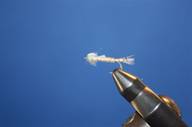
- Hook: TMC 101
- Sizes: 14-18
- Thread: 12/0 Sandy Dun
- Tails: Wood duck Flank Fibers
- Abdomen: Callibaetis Turkey Biot
- Wingcases: Gray Pheasant Tail Fibers, Tied Sawyer Style
- Thorax: Squirrel Brite Dubbing, Lite Gray
Fishing Notes: Though this pattern does not have any weight in its construction, it will sink and the materials soak up water. This is another pattern that I like to use during the emergence.
5. Wet Callibaetis Spinner-------Style #2
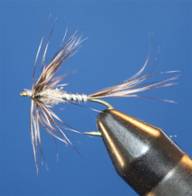
- Hook: TMC 101
- Sizes: 14-18
- Thread: 12/0 Lite Dun
- Tails: Wet Hen Grizzly Hackle Fibers, Tied Long
- Abdomen: Muskrat Gray Turkey Biots
- Thorax: Squirrel Brite Dubbing, Lite Gray
- Hackle: Wet Hen Grizzly, two wraps tied as a collar
Fishing Notes: Not all spinners are consumed by the trout on the surface of the water. Often, the trout will feed on the sunken spinner with a lot less caution. I have used this pattern extensively on spring creeks, tail-waters and on other slow moving streams which have Callibaetis Spinner falls.
On still-waters I will often fish the wet spinner about 24 inches behind the dry spinner; I am always amazed by how many fish take the drowned or wet spinner imitation. This imitation will float awash in the film or just beneath it.
6. Callibaetis Spider
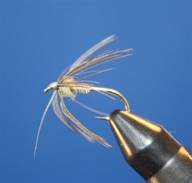
- Hook: Dai-Riki 70
- Sizes: 14-16
- Thread: 12/0 Sandy Dun
- Body: Tied Short, half the length of the hook shank, Callibaetis
- Turkey Wing Quill Fibers, wrapped.
- Thorax: Dubbed with Hareline Ice UV Lite Olive
- Hackle: Dun Back Feathers for a Valley Quail Skin, 1-1/2 wraps.
Fishing Notes: This is my favorite Callibaetis wet imitation, I think that the key to its success if the Dun Quail hackle as it impart a very life-like movement to the pattern. I have used it prior to the hatch, I have used it on trout that visibly feeding on dun or spinner. Seldom has it been refused by the trout.
In part two I will covering the emergers and my favorite dry fly patterns, so until next time.
Enjoy & Good Fishin’
From the Desk of the
Wandering Fly Tyer
